A customer journey is the set of interactions a customer has with your business to complete a task such as evaluating, onboarding, getting support, or renewing a product or service. A customer journey map is a visualization of an individual’s relationships with a product/brand over time and across different channels. It helps businesses better understand the customer experience including all the journey steps and touchpoints along the way to achieving their goals. By exposing the gaps between the user’s expectations and perceptions at key steps in the journey with associated departments and stakeholders.
A Customer Journey Map often represents as a timeline of all touch points between a user and a product. This timeline contains information about all channels that users use to interact with a product that typically involves breaking down traditional system, department and channel silos to unify and automate the customer engagement process. Cross-channel customer context is collected and analyzed to support continuous optimization of the customer experience over time.
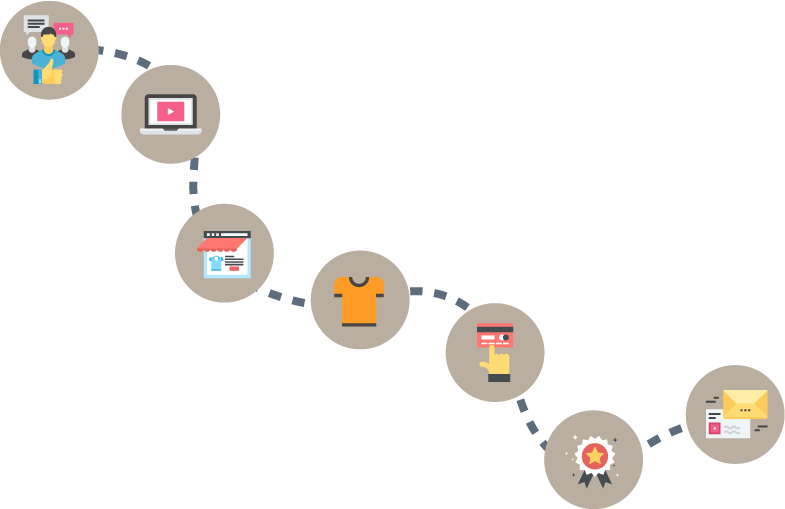
Customers are increasingly empowered by competition, digital channels and easy access to information such as, their devices become more integrated and connected to your business and systems via the Web, self-service and mobile apps. The customer’s buying cycle starts long before they visit the website – and the service and support experience continues long after they place their order.
This digital disruption is making customer experience a priority and shifting business focus from traditional systems of record to dynamic systems of engagement. Companies that fail to take the full buying cycle into account commonly under-deliver on customer expectations. Thus, the businesses force to reinvent themselves to increase customer value and deliver great experiences by re-factoring systems and processes to consistently support customers on these new touchpoints.
Customer journey maps can be useful beyond the UX design and marketing teams. They can help facilitate a common business understanding of how every customer should be treated across all sales, logistics, distribution, care, etc. channels. This in turn can help break down “organizational silos” and start a process of wider customer-focused communication in a business and consequently, a CJM helps us to achieve the following:
Customer journey map illustrates the relationship of a customer with a business over a period of time using storytelling technique and visual cues. Story are being told from the perspective of customer, which provides insights of the total experience from the customers, helping your get a better understanding and addresses customers’ needs and pain points as they experience your product or service. It is an excellent tool for UX designers to visualize how a user interacts with a product and allows designers to see a product from a user’s point of view.
Different parts of the organization such as marketing, sales, support and collections often only understand their portion of the user’s end-to-end journey. They naturally gravitate towards supporting their own touchpoints, which then creates organizational silos.
Customer Journey maps are a common approach used to design customer-centric processes for multi-channel customer engagement. The ultimate purpose of the exercise is to find flaws, weaknesses and opportunities for improvement in the current process. They often serve as:
So how do you virtualize the outside-in scenario to see the full picture including customer perceptions, mobile and social media engagement? The short answer is by creating journey maps which visually document a customer persona’s needs, perceptions and the touchpoints encountered for each step towards the customer’s journey goal.
The Inside-Out approach is guided by the belief that the inner strengths and capabilities of the organization will make the organization prevail. The Outside-In approach is instead guided by the belief that customer value creation, customer orientation and customer experiences are the keys to success.
Taking a journey-focused, outside-in approach to continuous UX optimization helps put the customer at the center of your business strategy, which in turn drives loyalty and revenue. Companies with a mature approach to customer experience take an iterative, disciplined approach to continuous improvement, with the ongoing assessment and optimization of customer journeys as a core practice.
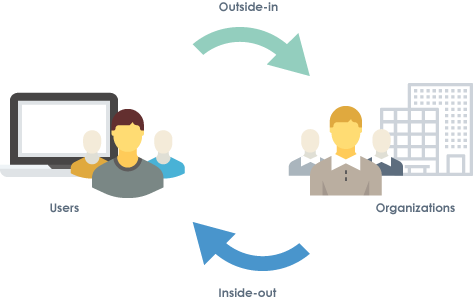
A pain point describes a moment in a customer’s experience that causes frustration, emotional discomfort, irritation or hassle which are the critical touchpoints encountered along his / her customer journey. Every badly managed touchpoint that is not designed in keeping with the brand leaves the customer with a negative experience; so it becomes a pain point which means that the overall customer experience turns negative.
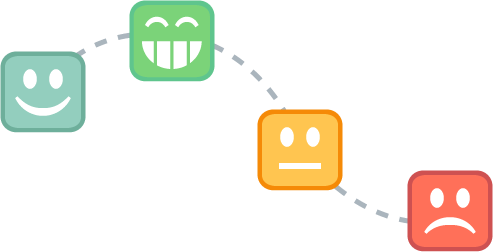
There many different types of pain points, but generally speaking, there are four typical types of pain points, all of which can be broken down into many smaller categories. These are the four main types and an example of a struggle associated with the problem.
Once you figure out the pain point(s) of your ideal customer, you can start thinking about how to position your company or product as a solution to your prospects’ problems.
Regardless of what’s causing the pain, you now have a pain point you can counter in your marketing. Remember our list of pain points from earlier in this post? Let’s take a look at the pain points we identified, and see how we could address them in our marketing:
Journey maps can take a wide variety of forms. The end goal, however, is always the same: find and resolve the pain points of your customers.
Personas and journey maps are both important strategic tools that help provide an in-depth understanding of who your customers are, what they need, and how they interact with your business across all touch points. But more importantly, for sharing customer insights across the organization. Much of the information for creating a journey map comes from your personas (e.g., their goals, motivations, key tasks they want to accomplish, and current pain points), which is why it’s best to create the personas first.
The first thing you need to decide is whose journey you are going to map such as, a specific customer type (persona), a potential (target) customer, or a segment of customers, depending on the purpose of your journey mapping initiative. Once you’ve created distinct personas, you can use them to create customer journey maps that describe each persona’s experience at various touch points during their lifecycle with your company.

Journey maps are typically organized by customer stages (sometimes referred to as phases). Each stage represents a major goal your customer is trying to achieve in their overall journey. You should build a customer journey map with stages that represent your customer’s goal-oriented journey, not your internal process steps.
So once you’ve defined your persona, you have to identify the stages of the customer’s journey. What process does it take to start from consideration all the way through buying your product or services? Based on the persona define the stages that your customer experiences with you over time. Define how, when and where they: discover your company, research your products or services, choose you over competitors, purchase from you, and maintain a relationship with you.
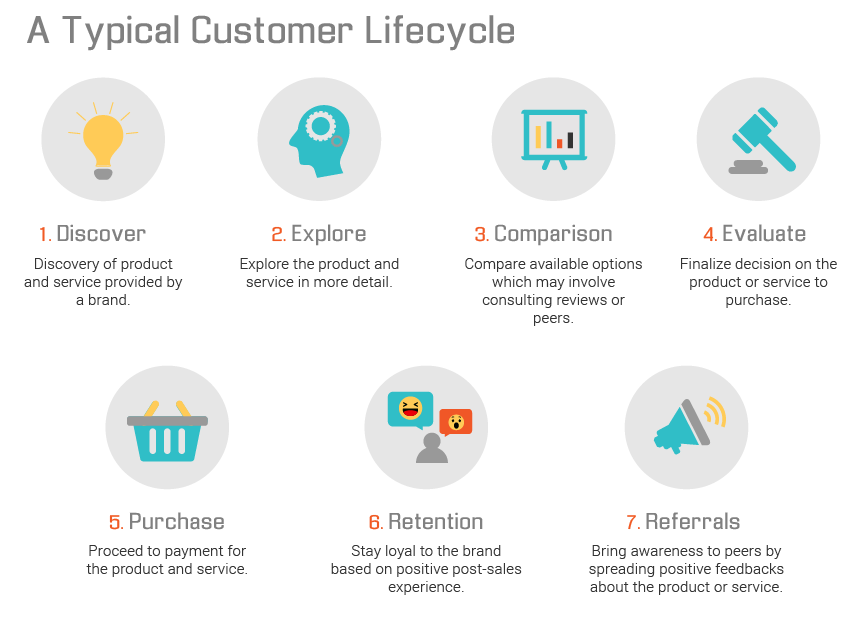
Customer touchpoints are your brand’s points of customer contact, from start to finish. For example, customers may find your business online or in an ad, see ratings and reviews, visit your website, shop at your retail store or contact your customer service. This seems like a long list, but these are just a few of your touchpoints! Identifying your touchpoints is an important step towards creating a customer journey map and making sure your customers are satisfied every step of the way.
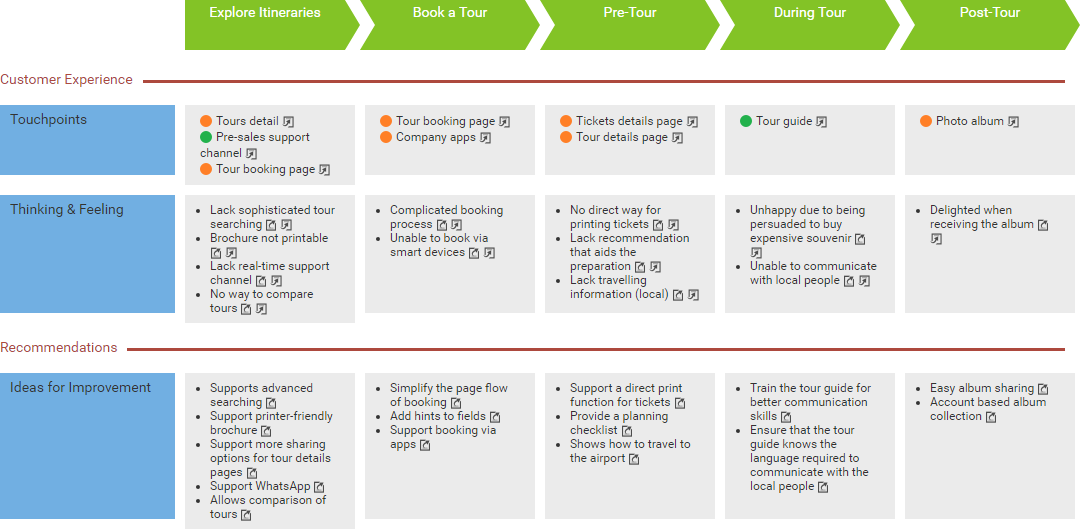
While you may need to offer some incentives for participation, most people are happy to help if they believe you are genuinely interested in their experience and will use their feedback to improve things for others.
Once you have understood your persona’s goals and written down their touchpoints, it’s time to look at the big picture – the totality of their experience with your company. Every business will look through the lens of their customer personas differently. Walking through each of the journey map stages with your team will help you identify any points of friction within the customer experience.
Of course, every business is different and YOU will know your customers best. There are a few example questions below to get you started:
Journey maps aren’t meant to be purely illustrative. A typical exercise should identify a few quick fixes, including opportunities to boost enjoyment and improve the journey. And, of course, most firms discover the process helps drive broader customer experience improvements as customer needs are better understood and met. In brief, mapping the journey should help lead to specific actions that improve the experience and drive the ROI. Treat your map as a living document to be revisited regularly and updated as required and remember to share it with any relevant stakeholders
Visual Paradigm’s online Customer Journey Mapping tool helps you streamline the UX initiatives and automate the entire information acquisition process:
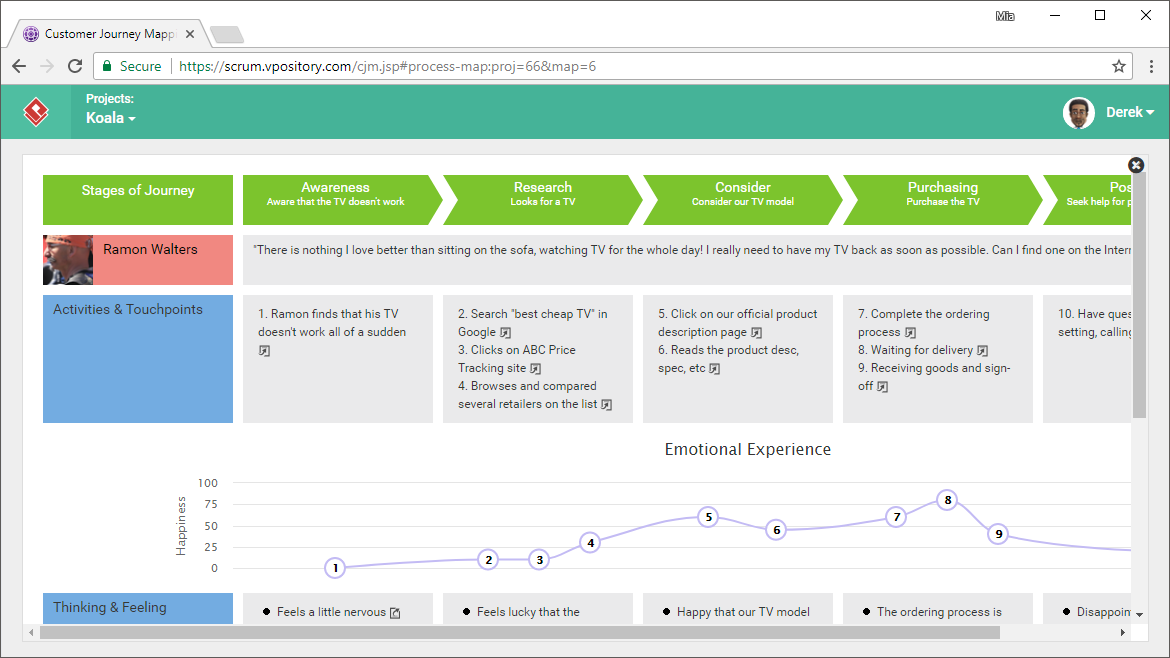
Visual Paradigm’s Customer Journey Mapping provide a compact visualization of an end-to-end customer experience. It helps businesses deepen their understanding of their customers’ behaviors, thoughts, and feelings, empowering businesses to make value-driven decisions based on a customer experience model.